Are you a Quiet Speculation member?
If not, now is a perfect time to join up! Our powerful tools, breaking-news analysis, and exclusive Discord channel will make sure you stay up to date and ahead of the curve.
I love it when a deck finally comes together. When all the faith is finally rewarded and the years of suffering and disappointment finally pay off. Mostly because it typically happens to decks that move from mediocre to barely viable. Think of Belcher, Ad Nauseam, the good stuff piles, or Ponza; decks that have been around, but could never find their place... until they could. It's happened to a deck that's near and dear to me, so that's what I'll be covering today.
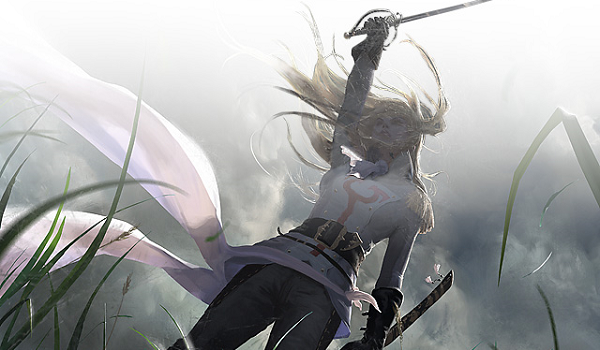
A History of Taxes
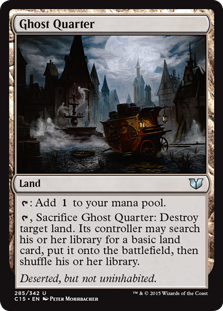 I have been playing and working on Death and Taxes (hereafter: DnT) for years. It's perpetually been a deck that's frustratingly almost there, but never really arrives. The only significant result was back in 2017 at GP Las Vegas. It was perfectly positioned to take apart the Death's Shadow field thanks to their weakness to Thalia, Guardian of Thraben and running the right protection creatures. Since then, there's been the odd blip, but it never really did anything.
I have been playing and working on Death and Taxes (hereafter: DnT) for years. It's perpetually been a deck that's frustratingly almost there, but never really arrives. The only significant result was back in 2017 at GP Las Vegas. It was perfectly positioned to take apart the Death's Shadow field thanks to their weakness to Thalia, Guardian of Thraben and running the right protection creatures. Since then, there's been the odd blip, but it never really did anything.
The problem, as I and every player that has tinkered with it over the years discovered, is that DnT could be tuned to beat anything, but never everything. It was an exceptionally tunable deck, but never had the raw power needed to dominate a field. All the combo decks? Lock them with Thalia, Eidolon of Rhetoric, and Spirit of the Labyrinth. Jund everywhere? Blade Splicer, Thraben Inspector, Leyline of Sanctity, and Restoration Angel. Tons of Burn? Auriok Champion, Kitchen Finks, Leyline, and Kabira Crossroads. You'd lose to anything else, but if you read the field right, DnT was rewarding.
The Turning Point
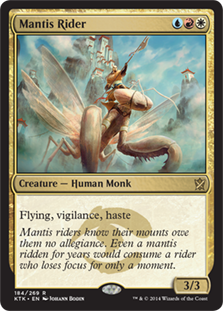 I won plenty of local events over the years thanks to correctly anticipating metagames and preparing accordingly. However, whenever I took DnT to wider metas, it just couldn't compete. The power and universality wasn't there. And Humans did a lot of the same things but with a faster clock, so why bother with the pet project? Until 2020, of course. DnT has exploded over the past month thanks to Zendikar Rising. So today I'll be looking at these finally successful builds and breaking down the card choices.
I won plenty of local events over the years thanks to correctly anticipating metagames and preparing accordingly. However, whenever I took DnT to wider metas, it just couldn't compete. The power and universality wasn't there. And Humans did a lot of the same things but with a faster clock, so why bother with the pet project? Until 2020, of course. DnT has exploded over the past month thanks to Zendikar Rising. So today I'll be looking at these finally successful builds and breaking down the card choices.
A New World
Surprisingly, there's very little variation in DnT's maindeck. As I'm going through the data for October, there's been a lot of DnT, and they're all built on the model set by Parrit.
Death and Taxes, Parrit (10/4 Challenge, 1st Place)
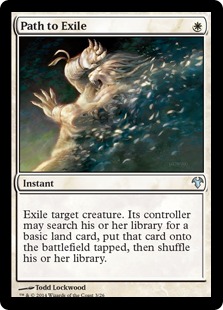 This is Parrit's deck from their best result so far, but honestly, I could have picked any event. Parrit's maindeck hasn't noticeably changed since Rising released online. This player is also personally responsible for close to half of DnT's results so far, so I had choices, but it makes the most sense to go with the best result.
This is Parrit's deck from their best result so far, but honestly, I could have picked any event. Parrit's maindeck hasn't noticeably changed since Rising released online. This player is also personally responsible for close to half of DnT's results so far, so I had choices, but it makes the most sense to go with the best result.
Around 90% of all DnT decks follow Parrit's numbers: Mono-white, 26 creatures, 4 Path, 4 Vial, 3 equipment, 23 lands. The specific choices deviate a bit, and I'll call attention to them, but this formula seems to have been accepted as "correct" for mono-white. Even the deviants and outliers don't stray too far, usually depending on whether or not they're running the Stoneforge package. There have been a few Boros versions and the odd Eldrazi and Taxes, but straight Mono-White DnT is by far and away the most popular. Even excluding Parrit. And digging in, it's not hard to see why.
The Taxes
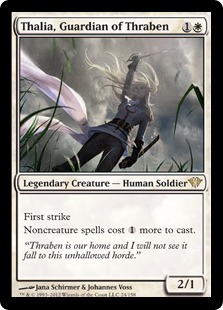 The key to the deck are the eight disruptive creatures, Thalia, Guardian of Thraben and Leonin Arbiter. I might have seen one list that didn't run full sets of each. Without these speedbumps, DnT cannot keep up with the rest of Modern. Thalia is better than Arbiter in the sense that noncreature spells see more play, and the tax is more consistently disruptive than soft search prevention, but that's balanced by Lava Dart. Arbiter is crippling against unprepared decks and makes Ghost Quarter into Strip Mine while Path to Exile becomes the best removal spell ever.
The key to the deck are the eight disruptive creatures, Thalia, Guardian of Thraben and Leonin Arbiter. I might have seen one list that didn't run full sets of each. Without these speedbumps, DnT cannot keep up with the rest of Modern. Thalia is better than Arbiter in the sense that noncreature spells see more play, and the tax is more consistently disruptive than soft search prevention, but that's balanced by Lava Dart. Arbiter is crippling against unprepared decks and makes Ghost Quarter into Strip Mine while Path to Exile becomes the best removal spell ever.
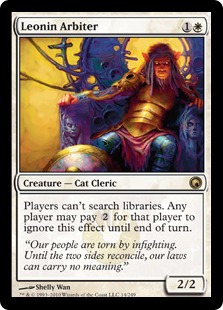 Both creatures form the heart of the deck. The trick is knowing which one is more relevant. As mentioned above, DnT is very much a deck that requires and rewards format knowledge. Given a choice, it is highly contextual which one to play first: not just the opponent's deck must be considered, but also how your own turns will play out. Playing Arbiter may or may not cripple the opponent's mana development, but it will make it harder to cast Stoneforge for several turns. Thalia may stunt the opponent's gameplan, but will also tax Path. Planning ahead and knowing what's most important in the matchup is key.
Both creatures form the heart of the deck. The trick is knowing which one is more relevant. As mentioned above, DnT is very much a deck that requires and rewards format knowledge. Given a choice, it is highly contextual which one to play first: not just the opponent's deck must be considered, but also how your own turns will play out. Playing Arbiter may or may not cripple the opponent's mana development, but it will make it harder to cast Stoneforge for several turns. Thalia may stunt the opponent's gameplan, but will also tax Path. Planning ahead and knowing what's most important in the matchup is key.
Stoneforge Package
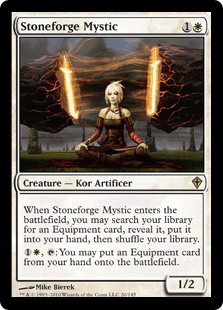 Stoneforge Mystic is the card advantage engine in the deck. In the past, it wasn't clear that she was better than the traditional Blade Splicer advantage engine, but every list I've seen so far has been on Stoneforge, so that's no longer the case. Despite reservations, Stoneforge has been a fine addition to the format. White needed the power boost, and it turns out that a turn three Batterskull is still very good. Given the competition after she was initially unbanned, it's taken a while and some metagame changes to break out, and a new printing certainly helped.
Stoneforge Mystic is the card advantage engine in the deck. In the past, it wasn't clear that she was better than the traditional Blade Splicer advantage engine, but every list I've seen so far has been on Stoneforge, so that's no longer the case. Despite reservations, Stoneforge has been a fine addition to the format. White needed the power boost, and it turns out that a turn three Batterskull is still very good. Given the competition after she was initially unbanned, it's taken a while and some metagame changes to break out, and a new printing certainly helped.
Maul of the Skyclaves
I missed Maul in my set review. It was just a big stick, and there are plenty of those already. The evasion was nice, but didn't seem better than the protection of a Sword. And the equip cost is prohibitive. What I missed was that the equip cost is mostly blank text. 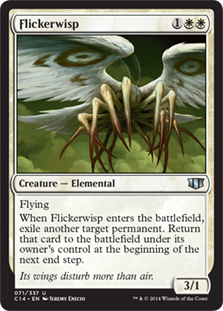 Equipping on entry is huge by itself, but it also synergizes with Flickerwisp. Thus, it has functions as a combat trick, stalemate breaker, and a normal equipment. A very strong pickup.
Equipping on entry is huge by itself, but it also synergizes with Flickerwisp. Thus, it has functions as a combat trick, stalemate breaker, and a normal equipment. A very strong pickup.
Sword of Fire and Ice
Initially the premier choice for Modern was Sword of Feast and Famine. Black and green were the biggest colors at the end of last year, so the Sword that defends against them was the right choice. Discard is also quite good. Times have changed, and now blue and red creatures are everywhere. Extra damage and cards are also always helpful.
Advantage Creatures
The bulk of the creature slots are the advantage creatures, those cards that fulfill some useful niche to support the two-drops and power the deck. I hope I don't have to note why Flickerwisp is good in a deck with Aether Vial by now; it just does everything, with myriad applications on both offense and defense. The other two could use some additional explanation.
Giver of Runes
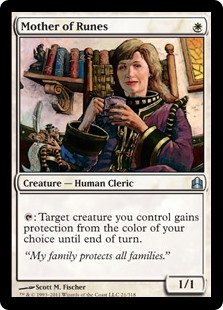 Giver has always suffered from not being Mother of Runes. Gaining a point of toughness and the ability to protect from colorless cards is solid, but not being able to protect herself really let the side down. In a world where Jund was a big player, it was too easy for Step-Mom of Runes to die uselessly. In Legacy, Bolting an untapped, active Mom ensures a two-for-one since she'll protect herself from the first Bolt. In Modern, it's no risk to Bolt Step-Mom, then Bolt whatever she tries to protect. I kept running Thraben Inspector over Giver as a result.
Giver has always suffered from not being Mother of Runes. Gaining a point of toughness and the ability to protect from colorless cards is solid, but not being able to protect herself really let the side down. In a world where Jund was a big player, it was too easy for Step-Mom of Runes to die uselessly. In Legacy, Bolting an untapped, active Mom ensures a two-for-one since she'll protect herself from the first Bolt. In Modern, it's no risk to Bolt Step-Mom, then Bolt whatever she tries to protect. I kept running Thraben Inspector over Giver as a result.
However, the format, and more importantly DnT, has changed. Protecting key creatures is far more important and far easier thanks to Jund and similar removal-dense decks falling away to make room for Prowess and counter-heavy Uro decks. Every DnT deck I've seen is running a full set, and I can't argue the point.
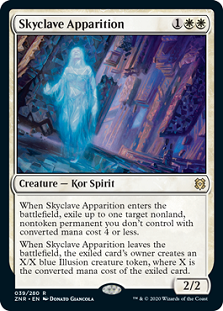 Skyclave Apparition
Skyclave Apparition
For all the talk I could have on format vulnerabilities or metagame positioning, Apparition is ultimately the real reason that DnT is a thing these days. See also everything I said in my preview article. And then amplify it by a factor, because Apparition is far better than expected. Modern seems to be uniquely vulnerable to Apparition thanks to an over-reliance on Uro and cheap planeswalkers. Absolutely a four-of right now.
The Utility Slot
The final two creature slots are the utility slots. There's no consensus on what goes here, and it's entirely about what holes the pilot thinks need filling. The three most popular options I've seen (in order) are Archon of Emeria, Restoration Angel, and Aven Mindcensor. There are advantages to each, and the "right" pick is a matter of personal taste and expected metagame.
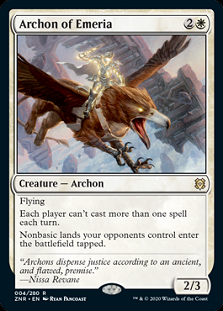 Archon of Emeria
Archon of Emeria
Again, take everything from my preview article and copy-paste it here. The current metagame is very favorable to land and spell disruption of this nature. The main problem is that Bolt appears to be on a general uptick thanks to Omnath, Locus of Creation. Thus, it's not quite as effective today as a few weeks ago. Also, while Archon is very effective against Ad Nauseam and Belcher combo, the Venegevine-based Oops All Spells has been getting a lot more attention, and it plays around Rule of Law effectively.
Restoration Angel
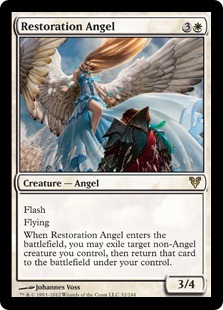 Angel is the old standby, and is at her best in a grindy metagame. Blanking even a single removal spell can be backbreaking against Jund or control. Being a 3/4 is also frequently relevant, and when blocking is essential, Resto will always be my pick. Current builds are not the best place for her, as there's no special way to get any value except blinking Apparition. Blocking isn't great right now given Prowess, and true attrition is down. Jund is Tier 2 and Omnath is about drawing lots of cards. The lower removal counts in the Omnath decks do make a single blink far more valuable, but on the whole I think Resto isn't the call, at least this month.
Angel is the old standby, and is at her best in a grindy metagame. Blanking even a single removal spell can be backbreaking against Jund or control. Being a 3/4 is also frequently relevant, and when blocking is essential, Resto will always be my pick. Current builds are not the best place for her, as there's no special way to get any value except blinking Apparition. Blocking isn't great right now given Prowess, and true attrition is down. Jund is Tier 2 and Omnath is about drawing lots of cards. The lower removal counts in the Omnath decks do make a single blink far more valuable, but on the whole I think Resto isn't the call, at least this month.
Aven Mindcensor
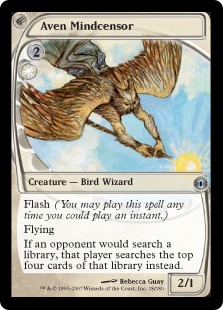 I have a strained relationship with this card. On the one hand, it is the best hard-counter for search effects in white and phenomenal against Primeval Titan, Scapeshift, and Bring to Light. On the other, Mindcensor has a long history of making promises to me it couldn't keep, dating back to failing to prevent Dragonstorm from going off five times at 2007 Regionals. Mindcensor can't prevent the opponent just having it, and counting on it does just lead to heartbreak. I think that having a few in the 75 is a good idea given how the meta is moving. However, the body is fragile enough and effect narrow enough I'd keep Mindcensor in the sideboard.
I have a strained relationship with this card. On the one hand, it is the best hard-counter for search effects in white and phenomenal against Primeval Titan, Scapeshift, and Bring to Light. On the other, Mindcensor has a long history of making promises to me it couldn't keep, dating back to failing to prevent Dragonstorm from going off five times at 2007 Regionals. Mindcensor can't prevent the opponent just having it, and counting on it does just lead to heartbreak. I think that having a few in the 75 is a good idea given how the meta is moving. However, the body is fragile enough and effect narrow enough I'd keep Mindcensor in the sideboard.
The Lands
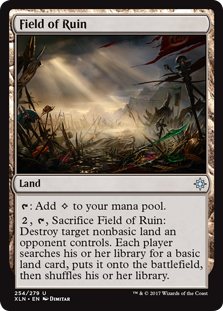 Every mono-white DnT list I've seen is running 23 lands. A few Boros lists run 21-22 because they're swapping a Field of Ruin or two for Cleansing Wildfire, but they're outliers. The overall breakdown has also very consistently been 11 Plains, 12 utility lands. The utility lands are typically distributed as 4 Horizon lands, 4 Ghost Quarter, 4 Field of Ruin. Again, as of writing, this specific distribution is at least 90% of the lists I've processed, so I'd call it the default. The main deviations are whether to run Horizon Canopy, Silent Clearing, or Sunbaked Canyon, and it really doesn't matter.
Every mono-white DnT list I've seen is running 23 lands. A few Boros lists run 21-22 because they're swapping a Field of Ruin or two for Cleansing Wildfire, but they're outliers. The overall breakdown has also very consistently been 11 Plains, 12 utility lands. The utility lands are typically distributed as 4 Horizon lands, 4 Ghost Quarter, 4 Field of Ruin. Again, as of writing, this specific distribution is at least 90% of the lists I've processed, so I'd call it the default. The main deviations are whether to run Horizon Canopy, Silent Clearing, or Sunbaked Canyon, and it really doesn't matter.
As a result, Parrit's list is something of an anomaly, despite being my Ur-example. They've opted to replace 2 Fields with Shefet Dunes and run Eiganjo Castle in place of a Horizon land. I'm not sure why Parrit runs one of every Horizon land; it offers no particular advantage, but there's no disadvantage, either. Maybe it's an availability thing? Or a weird flex? In any case, the unique cards deserve a deeper dive:
Eiganjo Castle
Personally, I can't stand this card. It's not bad, and I don't begrudge anyone running it, but I've never had good results with it. I imagine Parrit is running it to have another non-painful white source with upside, because actually protecting Thalia in Modern is a bit of a pipe dream.  Eiganjo does nothing against Lightning Bolt, rarely saves Thalia in combat, and requires two mana to stop a Lava Dart. It's a pale shadow of Karakas and I wouldn't bother.
Eiganjo does nothing against Lightning Bolt, rarely saves Thalia in combat, and requires two mana to stop a Lava Dart. It's a pale shadow of Karakas and I wouldn't bother.
Shefet Dunes
Dunes is more interesting. It's another white source, and DnT is very hungry for white sources, but it's a painful one. Between the Horizon lands and Dunes, DnT will do 2-5 points of damage to itself in many games. In a race situation, this can be the difference between victory and defeat. Dunes being a temporary Anthem is meant to close out a game. Thus, the damage advantage it gives is often balanced by the damage it gives away. In a field of UW Control, I'd absolutely run Dunes. With Prowess as a top deck, I'd shy away.
In the Sideboard
The beauty of DnT has always been the sideboard flexibility. White has always had the best hate cards and the widest range of sideboard options, so DnT could always tune to answer whatever decks were popular. As a result, the sideboard is very much a matter of personal taste and the current metagame. That said, there are a few cards in Parrit's list that need discussion:
Burrenton Forge-Tender
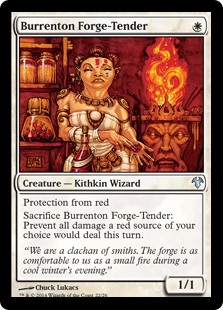 Forge-Tender is a very good card in a format where specific red spells need to be answered and/or blocked and/or Anger of the Gods is everywhere. This is pretty accurate at the moment. The issue is that Auriok Champion is generally better in more matchups, especially the Scourge of the Skyclaves decks that have started spiking up. Also, given Champion's popularity, a lot of decks are giving up on Anger in favor of Kozilek's Return. Therefore, I'd run Champion as my anti-red card and pack Selfless Spirit for sweepers.
Forge-Tender is a very good card in a format where specific red spells need to be answered and/or blocked and/or Anger of the Gods is everywhere. This is pretty accurate at the moment. The issue is that Auriok Champion is generally better in more matchups, especially the Scourge of the Skyclaves decks that have started spiking up. Also, given Champion's popularity, a lot of decks are giving up on Anger in favor of Kozilek's Return. Therefore, I'd run Champion as my anti-red card and pack Selfless Spirit for sweepers.
Phyrexian Revoker
Revoker is surprisingly relevant right now. With Belcher decks actually being a thing, DnT needs something to preempt the kill. Revoker is also strong against Tron, creature combo, and any planeswalker Apparition can't hit. Don't cut these, no matter how unimpressive they seem.
Leonin Relic-Warder
On the other hand, absolutely do not play this card. I know the siren call of synergy with Flickerwisp and being a creature in a creature deck. Don't be fooled. Playing Relic-Warder is asking to get hard-locked.
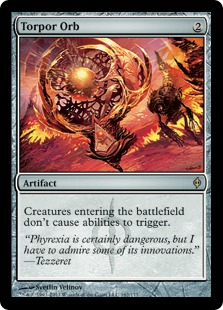 If the only deck that needed Relic-Warder as an answer was Affinity, that would be ok. Exiling a counter-laden creature is very good. However, the main decks with artifacts run Karn, the Great Creator. This lets them wish for Torpor Orb, and most do run a copy. Orb means all the ETB creatures are effectively textless, which means no answers to the Ensnaring Bridge follow-up. For that reason, DnT is better off with Disenchant or Revoke Existence.
If the only deck that needed Relic-Warder as an answer was Affinity, that would be ok. Exiling a counter-laden creature is very good. However, the main decks with artifacts run Karn, the Great Creator. This lets them wish for Torpor Orb, and most do run a copy. Orb means all the ETB creatures are effectively textless, which means no answers to the Ensnaring Bridge follow-up. For that reason, DnT is better off with Disenchant or Revoke Existence.
Certainties in Life
For those new to the archetype, the advice I'd give is be patient. DnT is not a typical Modern creature deck. It's slower, grindier, and far harder to play than it appears. It takes a lot of format knowledge to be good, and there's no small amount of luck in having everything line up perfectly. If you put in the time, you'll be rewarded. But make sure to get in those reps, because the right line can often be surprising.




Hey David,
What do you think of RW variants with Cleansing Wildfire and Magus? Or a UW Spooky Variant with Confounding Conundrum? Any merit to exploring those options?
The RW variants see some play, and have made me double take a few times as I gather data for the next metagame update. They give you a much better Tron and Amulet titan matchup, but there’s no real change to the Uro matchups and they’re pretty dead against Prowess. I think RW is a meta call.
As for UW, you’re so close to being straight Spirits as is that in most cases it’s better to just go all in on being Tribal. I remember one time seeing a Spooky Taxes deck, but it was far more Spooky than Taxes, so I classified it as Spirits. I don’t think there’s enough advantage to adding Thalia to deviate from straight Spirits.